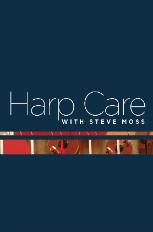Recently I witnessed a harp-moving accident. Well, actually, I was in a nearby room, but I heard the yelling and saw the blood when I came running. Thankfully, the only damage to the harp was cosmetic, and the blood was only from a minor scratch. Things could have been so much worse. The situation? Trying to maneuver a concert grand harp down a short flight of front steps on a dolly. I think there were only two steps, maybe three. The problem? Trying to descend the steps backwards, i.e., the person holding the dolly was going down the steps first and then pulling the dolly and harp after her.
Oh, I hear you saying, “I never go down stairs without someone to help me. This couldn’t happen to me.” However, in this case there were two people working together, and the harp still went overboard.
You might be tempted to pull your harp downstairs person first, harp second. It may seem to put less stress on your back. It may seem safer, as you reason that if you lose control the harp will fall on you. In essence you will act as a human shield for your harp. Okay, I can respect that. I know of more than one harpist who put their bodies on the line to save their harps, figuring it is easier to heal a human injury than save a broken harp.
I understand the high regard harpists have for their instruments, so I won’t criticize you for the (misguided) idea that your harp is more valuable than your health, but in any case, going down stairs underneath your harp is NOT safer for your harp. In all likelihood, if something goes wrong, your harp will not simply fall on you, but it will swing to one side or the other, as the one in this case did. If that happens, from your position downstairs, there will be nothing you can do about it. Your helper at the top of the stairs won’t have the leverage to stop an 85-pound harp that has decided to fly into the bushes, and you can’t let go of the dolly, as that will make things even worse.
If you go down the stairs backwards, you won’t be able to see the dolly’s wheels. It is crucial that they hit the steps at the same time to keep the harp balanced. When the wheels go over a stair and descend, there will be nothing you can do to stop their momentum, and the harp will crash down the steps. Even if it doesn’t topple over as a result, do you really want to put your harp through this?
It all happened too fast for me to take a picture, and in any case I certainly would have done something else to try and help. While it would be educational to show you a photo of the near disaster, I certainly wasn’t going to recreate it for a photo op. So, I direct your attention to the photo above, which shows the correct method of negotiating stairs. No matter which direction you are going, the person needs to be above the harp. Period. Yes, this can be hard on your back. The goal is to keep your back straight and bend your knees. Also, the more you lean the harp back on the dolly, the more control you will have. You will be able to control the speed at which the dolly rolls down each step.
Going up and down stairs the correct way isn’t easy. I know that. Unfortunately, the alternative is unsafe, both for you and for your harp, and for you helper if you have one. Don’t do it.
For an extensive tutorial on moving harps in all kinds of situations, check out my DVD, Harp Care with Steve Moss.



Geez. This makes me grateful for my 26-string harp I can carry up and down stairs!